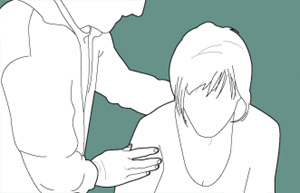Anxiety attack
| Panic attack | |
|---|---|
 |
|
| Someone experiencing a panic attack, being reassured by another person. | |
| Classification and external resources | |
| Specialty | Psychiatry |
| ICD-10 | F41.0 |
| ICD-9-CM | 300.01 |
| DiseasesDB | 30913 |
| MeSH | D016584 |
Panic attacks are sudden periods of intense fear that may include palpitations, sweating, shaking, shortness of breath, numbness, or a feeling that something bad is going to happen. The maximum degree of symptoms occurs within minutes. Typically they last for about 30 minutes but the duration can vary from seconds to hours. There may be a fear of losing control or chest pain. Panic attacks themselves are not dangerous.
Panic attacks can occur due to number of disorders including panic disorder, social anxiety disorder, post traumatic stress disorder, drug use, depression, and medical problems. They can either be triggered or occur unexpectedly. Risk factors include smoking and psychological stress. Diagnosis should involve ruling out other conditions that can produce similar symptoms including hyperthyroidism, hyperparathyroidism, heart disease, lung disease, and drug use.
Treatment of panic attacks should be directed at the underlying cause. In those with frequent attacks, counselling or medications may be used. Breathing training and muscle relaxation techniques may also help. Those affected are at a higher risk of suicide.
In Europe about 3% of the population has a panic attack in a given year while in the United States they affect about 11%. They are more common in females than males. They often begin during puberty or early adulthood. Children and older people are less commonly affected.
...
Wikipedia
